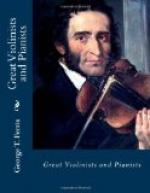In 1820 Robrechts returned to Brussels, where he was elected first violin solo to the king, Wil-helm I. It was shortly after this that De Beriot took lessons from him, and he it was who gave him the letter of introduction to Viotti. The same excellent professor also gave instructions to the young Artot. He died in 1860, the last direct representative of the great Viotti school.
It will now be seen where De Beriot acquired the first principles of that large, bold, and exquisitely charming style that in after life characterized both his performances and his compositions.
II.
Arriving at Paris, and believing probably that the classical style of Robrechts, from whom he had had instruction in Brussels, did not lead him swiftly forward enough in the path he would travel, he sought Viotti, as we have related above, and by his advice entered himself in the violin class of the Conservatoire, which was directed by Baillot, an eminent player of the Viotti school, though never a direct pupil of the latter master. De Beriot, however, did not remain long in the class, but applied himself most assiduously to the study of the violin in his own way. This is what Paganini had done, and through this course had been able to form a style so peculiarly his own. It is not probable that De Beriot at this time knew much about Paganini; certainly he had never heard him. Paganini was at first looked on as a mere comet of extraordinary brilliancy, without much soundness or true genius, and many who afterward became his most ardent admirers began with sneering at his pretensions. De Beriot was in later years undoubtedly powerfully influenced by Paganini, but at the time of which we speak the young violinist appears to have been determined to evolve a style and character in art out of his own resources purely. He was carrying out Viot-ti’s advice.
At this time our young artist was the possessor of a very fine instrument by Giovanni Magini, a celebrated maker of the Brescian school, and a pupil of Gaspar de Salo. Many of the violins of this make are of an excellence hardly inferior to the Strads of the best period, and De Beriot seems to have preferred this violin during the whole of his career, though he afterward owned instruments of the most celebrated makers.
Very soon De Beriot made his public appearance in concerts, and was brilliantly successful from the outset. The range of his ambition may be seen from the fact that he had enough confidence in his own genius from the very first to play his own music, and it was conceded to possess great freshness and originality. These early “Airs Varie” consisted of an introduction, a theme, followed by three or four variations, and a brilliant finale.




